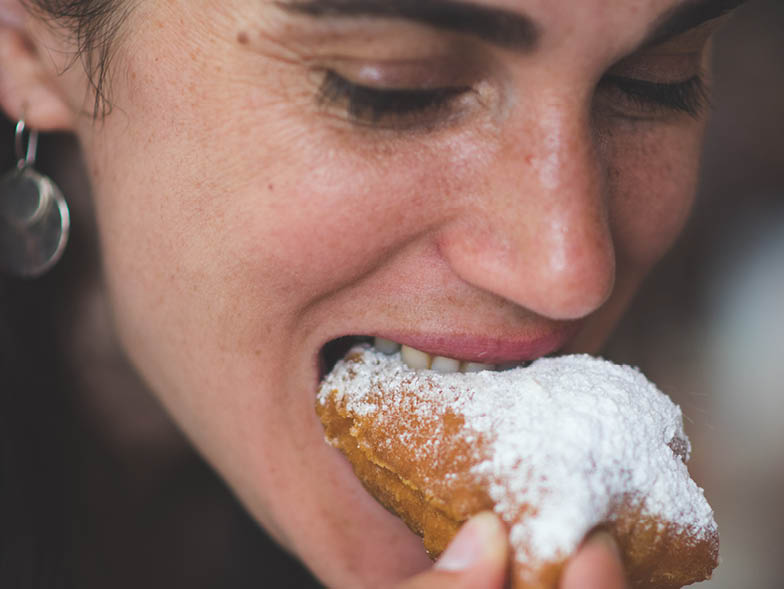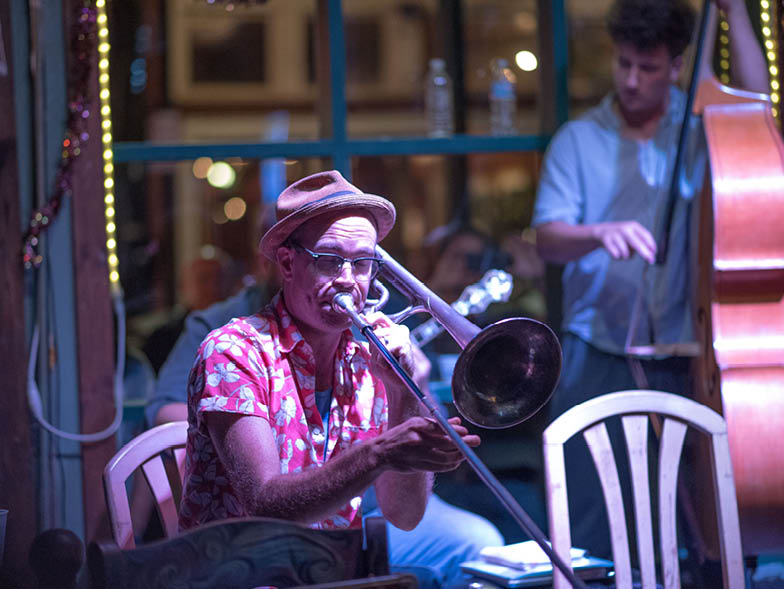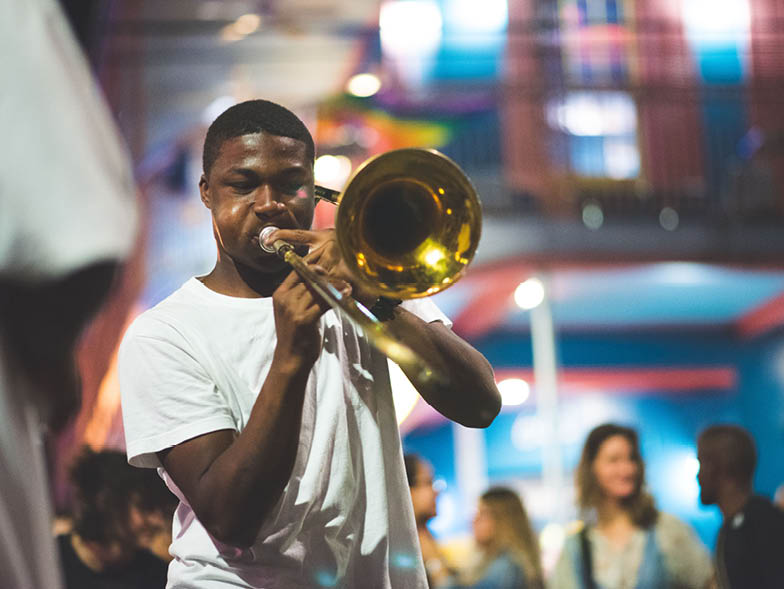I Know What It Means To Miss New Orleans
We sat on brightly colored wooden stools scooted up to a corrugated aluminum bar at Dat Dog, a New Orleans institution. Patrons at the horseshoe-shaped counter gobbled up crawfish-etouffee-topped kielbasa chased with chili cheese fries. The place buzzed with an electricity and a flavor that belong only to New Orleans.
Suddenly, the sounds of brass swept in through the open doors, and I grabbed my camera to investigate what was transpiring outside in the humid night air. A marching band had set up camp on the corner of Frenchmen Street, playing rousing tunes while a thin and muscular man wearing light-up Rollerblades swerved and breakdanced in the intersection. Flipped upside down, his neon-clad feet bobbed up and down rhythmically against the nighttime sky. A crowd quickly formed around the impromptu performance, which I would later learn was an audition of sorts for a Coca-Cola commercial.
This spontaneous creativity, it turns out, is an everyday affair in the Big Easy, where musicians and artists have found a home that supports their talents. Frenchmen Street, located at the edge of the French Quarter, is considered the main drag for audiophiles and tourists seeking jazz, with at least fifteen live music clubs. One such club, the Spotted Cat, packs a lot of punch into a minimal space. In the sweltering summers, it’s an air-conditioned oasis, with a stage, a bar, and a tiny sliver of dance floor just big enough to squeeze two couples, or, on especially crowded nights, some listeners who are willing to grab a seat on the floor to get up close and personal with the musicians.

Shotgun Jazz Band, led by Marla Dixon and her husband, John, light up this space weekly with revival jazz—a style of jazz popular in the late 1940s and early 1960s. Charlie Halloran, trombonist and official member of Shotgun Jazz Band, explains, “These were the musicians that had come up playing in the 1920s and 1930s who were brought out of retirement from being deckhands, barbers, or tailors. It’s a romping, stomping, no-frills, straightforward style of traditional jazz.” Halloran plays in several bands, a common occurrence in the New Orleans music scene. He jokes, “There are almost as many bands as there are musicians.”
All the bands in New Orleans are incredibly open to musicians sitting in. When he first moved to New Orleans, Halloran bought the albums of the bands he liked, learned the repertoire, and showed up to their performances to create an opportunity to sit in. “Eventually, someone goes on vacation or someone moves away, and you are asked to sub in,” he reveals. Halloran still speaks like a starstruck teenager when reflecting on the musicians he admired growing up, who are now his friends—people like trumpet player Wendell Brunious and jazz singer Banu Gibson.
On Friday night, a music club down the street called d.b.a. featured the band Tuba Skinny. Compared to the Spotted Cat, d.b.a. is a sprawling venue—made up of two rooms with a two-sided bar in the middle. One side contains a stage and a wonderfully worn wooden dance floor, the latter of which was already filled with local swing dancers—some channeling 1920s and 1930s fashion.

Halloran was sitting in as a horn, though he’s not a touring member. Says Halloran, “I enjoy the group dynamics of New Orleans jazz—two or three horns playing at the same time, filling in for each other. I can fill in with a low note, or I can take the melody and someone else can play some ornamental notes around it. It’s the collective that makes New Orleans music so special.”
One of Halloran’s favorite places to play is the renowned Preservation Hall, a very cozy, acoustic-only music hall. He explains, “Everyone is there to listen to the music. There is no bar there. You can’t have your phone out during the performance. People are practically sitting in each other’s laps because it’s so tiny. It’s wood, and it sounds really good. And everyone is there for the same reason—to appreciate some really amazing music.”
And no trip to New Orleans would be complete without a serenade by Kermit Ruffins, trumpet player extraordinaire. After leaving the Rebirth Brass Band, a group he cofounded when he was still in high school, Ruffins went solo and is now backed by the Barbecue Swingers. Ruffins was cracking jokes from the stage and riffing off the crowd at the Blue Nile.

Halloran is here in New Orleans for the long haul, moving from the East Coast after completing his graduate degree in jazz trombone. He and his wife bought a house on the West Bank, close to the levy, where they live with their dogs. Between the Shotgun Jazz Band, Palmetto Bug Stompers, Meschiya Lake and the Little Big Horns, and the Panorama Jazz Band, Halloran is playing almost every night. It’s not an easy feat to make a living solely as a musician, but New Orleans is the place to do it. For Halloran, living in New Orleans is a dream come true. The New Orleans-style jazz has been his first love since the beginning days of his musical career—the role of the trombones is so significant. Though he learned to be okay with more modern styles of jazz, he fell in love with the melodies and collective improvisation of traditional jazz.
This Louisiana hub also nurtures its artists and artisans, with paintings and photographs everywhere you turn—art galleries, boutiques, and eateries, like Fair Grinds Coffeehouse in Mid-City, are filled with the works of local talent. At the open-air French Market, crafters and artists congregate to sell their goods, like fresh cotton-scented candles and endless wares shaped like the fleur-de-lis. The market is also packed to the gills with food vendors selling everything from local plums to alligator jerky. Meals From the Heart Café is famous for its crab cake sandwiches, and rightly so. Served with coleslaw and orange slices while you wait, this sandwich was so dreamy it enjoyed an encore performance the next day.
There is an intangible buzz that reaches into all the nooks and crannies of this bayou and infuses its inhabitants—tourists and residents alike—with creative electricity. The air is thick and hot, and the sounds of makeshift tap shoes, throaty vocals, and horns blowing their breathy notes fill the city. Without a doubt, New Orleans is a place that continues to lure musicians, artists, craftsmen, dancers, and all creators to share space, connect, and express.
For more info, visit www.charliehalloran.com.






















